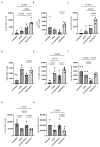Mitochondrial Creatine Kinase 2 (Ckmt2) as a Plasma-Based Biomarker for Evaluating Reperfusion Injury in Acute Myocardial Infarction
- PMID: 39457679
- PMCID: PMC11504053
- DOI: 10.3390/biomedicines12102368
Mitochondrial Creatine Kinase 2 (Ckmt2) as a Plasma-Based Biomarker for Evaluating Reperfusion Injury in Acute Myocardial Infarction
Abstract
Background/objectives: Acute myocardial infarction (AMI), characterized by irreversible heart muscle damage and impaired cardiac function caused by myocardial ischemia, is a leading cause of global mortality. The damage associated with reperfusion, particularly mitochondrial dysfunction and reactive oxygen species (ROS) formation, has emerged as a crucial factor in the pathogenesis of cardiac diseases, leading to the recognition of mitochondrial proteins as potential markers for myocardial damage. This study aimed to identify differentially expressed proteins based on the type of cardiac injury, in particular those with and without reperfusion.
Methods: Male C57Bl/6J mice were either left untreated, sham-operated, received non-reperfused AMI, or reperfused AMI. Twenty-four hours after the procedures, left ventricular (LV) function and morphological changes including infarct size were determined using echocardiography and triphenyl tetrazolium chloride (TTC) staining, respectively. In addition, plasma was isolated and subjected to untargeted mass spectrometry and, further on, the ELISA-based validation of candidate proteins.
Results: We identified mitochondrial creatine kinase 2 (Ckmt2) as a differentially regulated protein in plasma of mice with reperfused but not non-reperfused AMI. Elevated levels of Ckmt2 were significantly associated with infarct size and impaired LV function following reperfused AMI, suggesting a specific involvement in reperfusion damage.
Conclusions: Our study highlights the potential of plasma Ckmt2 as a biomarker for assessing reperfusion injury and its impact on cardiac function and morphology in the acute phase of MI.
Keywords: biomarker; mitochondrial damage; myocardial infarction; reperfusion injury.
Conflict of interest statement
The authors declare no conflicts of interest.
Figures



References
-
- Mechanic O.J., Gavin M., Grossman S.A., Ziegler K. Acute Myocardial Infarction (Nursing) StatPearls; Saint Petersburg, FL, USA: 2021. - PubMed
Grants and funding
LinkOut - more resources
Full Text Sources

